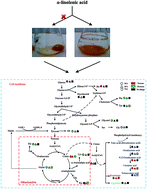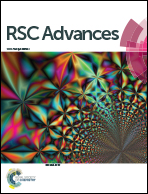Metabolic regulation of α-linolenic acid on β-carotene synthesis in Blakeslea trispora revealed by a GC-MS-based metabolomic approach†
Abstract
Alpha-linolenic acid (ALA) is known for its ability to promote the production of β-carotene in Blakeslea trispora. However, the mechanism is still poorly understood. In this study, gas chromatography-mass spectrometry (GC-MS)-based metabolomic approach and multivariate analysis were used to study mechanisms underlying the regulation effects of ALA on β-carotene synthesis in B. trispora. ALA treatment promoted the biomass of B. trispora and β-carotene production. The maximum β-carotene production 5.344 mg L−1 was realized after 72 h of cultivation in the presence of 50 μL ALA. The intracellular metabolite profiles found upon treatment of the cells with different addition time points of ALA were unique and could be distinguished from the aid of principal component analysis (PCA). Furthermore, partial least-squares-discriminant analysis (PLS-DA) revealed a group classification and pairwise discrimination between the control and ALA treated groups, and 28 differential metabolites with variable importance in the projection (VIP) value greater than 1. The addition of ALA decreased the glycolysis, TCA cycle and fatty acid synthesis. The accumulation of linolenic acid and linoleic acid indicated that ALA was directly absorbed by the fungus and transformed into its own linolenic acid. As a result, the flux from acetyl-CoA to β-carotene synthesis increased. Besides, the addition of ALA increased the level of dissolved oxygen and the production of β-carotene.


 Please wait while we load your content...
Please wait while we load your content...